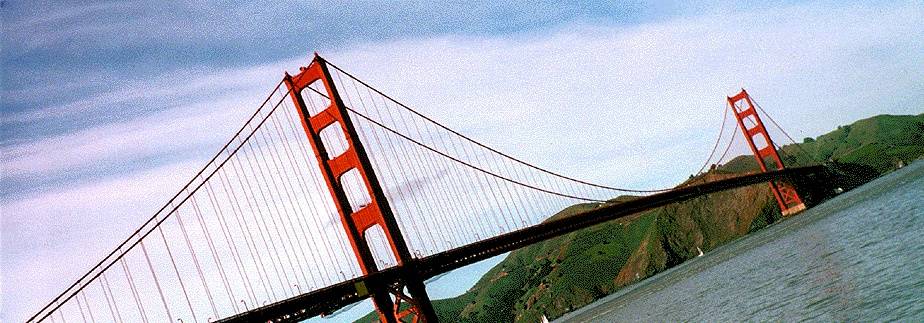A Suicide Barrier?: Difference between revisions
No edit summary |
(No difference)
|
Revision as of 17:00, 14 January 2001
The Golden Gate Bridge in 1997.
Long before AIDS, many San Franciscans defended the right to suicide by opposing an antisuicide barrier on the Golden Gate Bridge, where one can easily climb the chest-high railing and take a 240-foot, four-second, 80-miles-an-hour flight to near certain death. The Bridge Authority commissioned the first design for a barrier in 1953, but though 15 more designs have since been commissioned and the estimated price has gone from $200,000 to $3 million, they have never proceeded with construction. Instead, they bought a closed-circuit television for the toll office, so that workers can scan the bridge and dispatch highway patrol officers when anyone behaves suspiciously.
Each time suicide prevention activists press for an antisuicide barrier, arguments rage in the daily newspaper columns and letters to the editors. It would mar the beauty of the bridge, say the opponents. The force of high winds blowing against a rigid barrier could damage the bridges superstructure. It would cost too much and people who really want to kill themselves will eventually do it one way or another. And why shouldnt they be able to jump off the bridge if thats what they want to do? Two-thirds of letters to Bridge directors have opposed a barrier, and many defended personal freedom to commit suicide.
Though the Catholic Church still lists suicide as a mortal sin, the task of suicide prevention passed from the moral to the medical professions during the eighteenth and nineteenth centuries. Like homosexuality, self-murder was condoned in the ancient world, condemned during the Middle Ages, and then pathologized with the rise of medical science and psychiatry. Accordingly, mental health professionals make most of the arguments for a suicide barrier on the Golden Gate Bridge.
Now, in March 1997, the Golden Gate Bridge Authority is again considering a suicide barrier on the bridge. They say that the latest design, a fence of high tension wires extending six feet above the existing railing, eliminates aesthetic and engineering safety concerns. The narrow wire would be unobtrusive, fenceposts would be placed one hundred feet apart to keep views open, and the barriers flexibility would keep it from endangering the bridge structure during high winds. Those who object to the $3 million cost and those who defend the right to die may be the new design's only opponents.
Forty-four years have passed since the Golden Gate Bridge Authority set the first barrier design aside. Though the authority has never raised the a liberty defense, its repeated decisions against erecting a suicide barrier have been consistent with San Francisco's longstanding preoccupation with personal freedom. Gay mecca, heart of the hippie revolution, bastion of political radicalism, home to left, right, center, and cyber libertarians, this is a city where morning and evening traffic reporters routinely warn of demonstrators slowing cars to assert their rights or the rights of others. Less often, they warn of traffic jams on the bridge caused by suicides or attempts. What are we known for more than our tolerance and determination to pursue our own paths except, perhaps, the Golden Gate, our beautiful, lethal bridge?
--Ann Garrison, from the essay "Suicide in the City" in Reclaiming San Francisco: History, Politics and Culture, A City Lights Anthology, 1998
Contributors to this page include:
Carlsson,Chris - Photographer-Artist
Garrison,Ann - Writer

